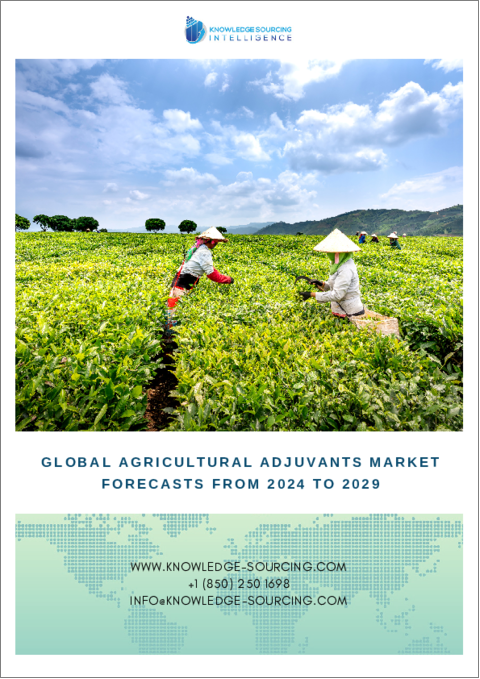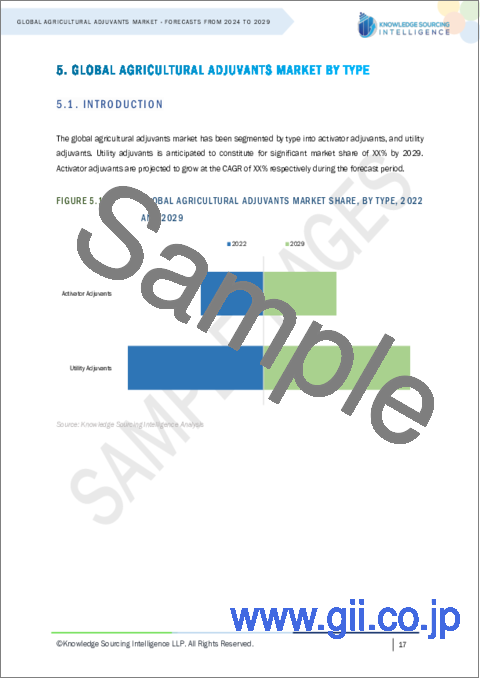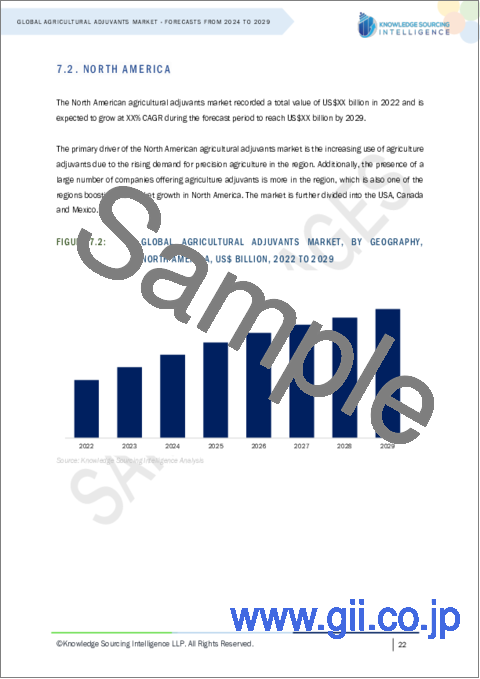|
|
市場調査レポート
商品コード
1456871
農業用アジュバント市場-2024年から2029年までの予測Agricultural Adjuvants Market - Forecasts from 2024 to 2029 |
||||||
カスタマイズ可能
|
|||||||
| 農業用アジュバント市場-2024年から2029年までの予測 |
|
出版日: 2024年02月12日
発行: Knowledge Sourcing Intelligence
ページ情報: 英文 135 Pages
納期: 即日から翌営業日
|
全表示
- 概要
- 目次
世界の農業用アジュバント市場は、予測期間を通じてCAGR 4.26%を記録し、2029年には48億900万米ドルの市場規模に達すると予測されます。これは、2022年に記録された35億9,100万米ドルからの増加を意味します。
農業用アジュバントは、肥料や農薬の植物表面への浸透性、付着性、分散性を高め、作物保護と養分供給の効能を全体的に改善するのに役立ちます。農業アジュバントは、農業で使用される主要投入物の効果を高めるサプリメントです。農薬や肥料のような投入物の経済的な使用を求める持続可能な農業慣行への注目の高まり、作物保護の改善と農業生産性の向上に対する需要の増加、精密農業技術の採用が、農業用アジュバント市場を牽引する主要要因です。さらに、環境への影響を低減しながらアジュバントの効果を高める製剤や技術の市場開拓により、市場はさらに拡大しています。
室内農業の普及が製品需要を促進
農業用アジュバント市場は、室内農業における精密農業技術の使用によって大きな影響を受けています。作物管理の精度は、温室や垂直農場のような管理された条件で定義される室内農業では不可欠です。これに関連して、農業用アジュバントは殺虫剤や除草剤のような農薬の効果を高めるので不可欠です。アジュバントは、可能な限り最良の結果を得るのに役立ち、屋内農場の規制された状況では、これらの化学物質を正確かつ効率的に投与する必要があります。サウジアラビアの大手垂直農場企業iFarmが発表したデータによると、垂直農場に対する意識の高まりと耕地面積の増加により、iFarm Vertical Farmsの年間収益は2021年の7万2,000ドルから2022年には7万4,000ドルに増加しました。さらに、さまざまな参入企業による屋内農業の成長のためのイニシアチブは、世界の農業用アジュバント市場をさらに活性化しています。例えば、2021年6月、屋内垂直農業のパイオニアであり、認定B企業であるAeroFarms社の最新鋭の研究センターがアブダビで着工しました。アラブ首長国連邦にある同社の完全子会社AeroFarms AgX LTDは、屋内垂直農法、イノベーション、AgTechの最新の進歩のみに焦点を当てる計画でした。さらに2023年5月には、世界で最も技術的に洗練された屋内垂直農場「プレンティ・コンプトン・ファーム」がカリフォルニア州コンプトンでデビューしました。市街地の1ブロックを使って、年間450万ポンドの葉物野菜を栽培しています。プレンティが保有する数多くの特許資産が、その革新的な3D垂直設計を可能にし、1エーカーあたり従来の農場の最大350倍という業界トップクラスの生産量を実現しています。
さらに、国連の試算によると、2050年までに地球はさらに23億人を養う必要があり、その大半は農業地域から遠く離れた都市に住むことになります。これに対処するため、NASAは垂直農業の原理を実用レベルで導入し、国内初の垂直農場を建設しました。技術者たちは、マーキュリー宇宙船のテストに使われていた廃虚のような低圧室の壁に水耕栽培トレイを積み上げました。そして、入手しやすい部品を使い、照明、換気、水循環のシステムを構築しました。積み重ねられたトレイの上に、いくつかの作物が植えられ、太陽光や新鮮な空気の助けを借りずに、水中でどれだけ育つか確認されました。
北米地域における農業用アジュバント調理器の世界市場は、着実に成長すると予測されています。
農業用アジュバント市場は米国で成長すると予想されています。これは、ダウ・ケミカル社などの企業の存在と相まって、市場での精密農業の使用が増加していることに起因しており、すべてが今後数年間の市場成長に拍車をかけています。さらに、米国の農業用アジュバント市場の成長は、主にアジュバントと組み合わせた農薬の大幅な利用によって牽引されています。農業の生産性向上への注目の高まりは、化学薬品の使用量の増加につながり、結果としてアジュバントの需要を押し上げています。農薬・農薬セクターの収益が一貫して右肩上がりであることは、農薬の好成長パターンを示しています。このことは、予測期間を通じて米国の農業用アジュバント市場を前進させると予測されます。米国農務省によると、2021年の米国の国内総生産(GDP)に対する農業、食品、関連産業の貢献は合計で約1兆2,640億米ドルで、シェアは5.4%に相当します。特に、米国の農場が生み出す生産高は、このうち1,647億米ドルを占め、米国GDP全体の約0.7%を占めています。したがって、米国の農業セクターの成長は、農業用アジュバントの市場を押し上げると予想されます。
目次
第1章 イントロダクション
- 市場概要
- 市場の定義
- 調査範囲
- 市場セグメンテーション
- 通貨
- 前提条件
- 基準年と予測年のタイムライン
- 利害関係者にとっての主要メリット
第2章 調査手法
- 調査デザイン
- 調査プロセス
第3章 エグゼクティブサマリー
- 主要調査結果
- アナリストビュー
第4章 市場力学
- 市場促進要因
- 市場抑制要因
- ポーターのファイブフォース分析
- 業界バリューチェーン分析
- アナリストビュー
第5章 タイプ別の世界の農業用アジュバント市場
- イントロダクション
- 活性化剤アジュバント
- 市場動向と機会
- 成長の展望
- 地理的収益性
- オイルアジュバント
- 界面活性剤
- 公益事業アジュバント
- 市場動向と機会
- 成長の展望
- 地理的収益性
第6章 用途別の世界の農業用アジュバント市場
- イントロダクション
- 除草剤
- 市場動向と機会
- 成長の展望
- 地理的収益性
- 殺虫剤
- 市場動向と機会
- 成長の展望
- 地理的収益性
- 殺菌剤
- 市場動向と機会
- 成長の展望
- 地理的収益性
- その他
- 市場動向と機会
- 成長の展望
- 地理的収益性
第7章 地域別の世界の農業用アジュバント市場
- イントロダクション
- 北米
- タイプ別
- 用途別
- 国別
- 南米
- タイプ別
- 用途別
- 国別
- 欧州
- タイプ別
- 用途別
- 国別
- 中東・アフリカ
- タイプ別
- 用途別
- 国別
- アジア太平洋
- タイプ別
- 用途別
- 国別
第8章 競合環境と分析
- 主要企業と戦略分析
- 市場シェア分析
- 合併、買収、合意とコラボレーション
- 競合ダッシュボード
第9章 企業プロファイル
- Croda International
- The DOW Chemical Company
- Solvay S.A.
- Clariant International AG
- Brandt(Cevital)
- Ingevity
- Bayer Crop Science
- Interagro
The global agricultural adjuvants market is expected to experience a CAGR of 4.26% throughout the forecast period, reaching a market size of US$4.809 billion by 2029. This represents an increase from US$3.591 billion recorded in 2022.
Agriculture adjuvants help increase the penetration, adhesion, and dispersion of fertilizers and pesticides on plant surfaces, improving overall crop protection and nutrient delivery efficacy. They are supplements that enhance the effectiveness of the main inputs used in agriculture. Growing focus on sustainable agricultural practices, which call for the economical use of inputs like pesticides and fertilizers, the increasing demand for improved crop protection and increased agricultural productivity, and the adoption of precision farming techniques are the major factors driving the agricultural adjuvants market. In addition, the market is further growing because of developments in formulations and technologies that enhance adjuvant effectiveness while lowering environmental impact.
Increasing adoption of indoor farming to propel the product demand.
The agricultural adjuvants market is significantly impacted by the use of precision agriculture techniques in indoor farming. Crop management accuracy is essential in indoor farming, which is defined by controlled conditions like greenhouses and vertical farms. In relation to this, agricultural adjuvants are essential since they increase the effectiveness of agrochemicals like pesticides and herbicides. Adjuvants help to get the best outcomes possible, and the regulated circumstances of indoor farms need the precise and efficient administration of these chemicals. According to the data published by iFarm, a leading vertical farm company in Saudi Arabia, the annual revenue of iFarm Vertical Farms increased from 72 thousand dollars in 2021 to 74 thousand dollars in 2022 owing to the growth in awareness of vertical farms and increasing arable land. Moreover, initiatives for the growth of indoor farming by various players is further fueling the agricultural adjuvants market worldwide. For instance, in June 2021, the state-of-the-art Research Center for AeroFarms, a pioneer in indoor vertical farming and a certified B Corporation, began construction in Abu Dhabi. AeroFarms AgX LTD, the company's wholly-owned subsidiary in the United Arab Emirates, planned to focus solely on the newest advancements in indoor vertical farming, innovation, and AgTech. Additionally, in May 2023, the world's most technologically sophisticated indoor vertical farm, the Plenty Compton Farm debuted in Compton, California. Its one city block was used to grow up to 4.5 million pounds of leafy greens a year. Numerous patent assets held by Plenty enables it, such as its innovative 3D vertical design, which powers the farm's industry-leading production of up to 350 times that of a traditional farm per acre.
Furthermore, according to UN estimates, Earth will need to feed an additional 2.3 billion people by 2050, the majority of whom will live in cities far from agricultural areas. To deal with this, NASA implemented vertical farming principles on a practical level, having constructed the nation's first vertical farm. Technologists piled hydroponic trays against the walls of a defunct hypobaric room that had been used to test the Mercury space spacecraft. Then, using readily available components, systems for lighting, ventilation, and water circulation were built. On the stacked trays, several crops were planted to see how well they would grow in water and without the aid of sunlight or fresh air.
It is projected that the global agricultural adjuvants cooker market in the North American region will grow steadily.
The agricultural adjuvants market is expected to propel in the United States. This is owing to the increasing use of precision agriculture in the market coupled with the presence of companies such as the Dow Chemical Company, are all adding to the market growth in coming years. Additionally, the United States agricultural adjuvants market growth is driven by the substantial utilization of agrochemicals, primarily in conjunction with adjuvants. Increasing focus on augmenting agricultural productivity is leading to heightened chemical application, consequently boosting the demand for adjuvants. The consistent upward trajectory in revenue within the pesticides and agricultural chemicals sector signifies a positive growth pattern for pesticides. This, in anticipation, is projected to drive the United States agriculture adjuvant market forward throughout the forecast period. According to the U.S. Department of Agriculture, in 2021, the combined contribution of agriculture, food, and related industries to the U.S. gross domestic product (GDP) was approximately $1.264 trillion, representing a 5.4% share. Specifically, the output generated by American farms accounted for $164.7 billion of this total, constituting approximately 0.7 percent of the overall U.S. GDP. Hence, the rising agriculture sector in the United States is expected to boost the market for agricultural adjuvants.
Market Key Developments
- September 2023, AtloxTM BS-50, a delivery system designed to particularly address the demands of the expanding biopesticide sector, was launched by Croda. The agricultural industry is moving towards more environmentally friendly goods, and biopesticides made of natural ingredients are being investigated extensively as a potential solution.
- February 2020, AltaHance, a new bio-based adjuvant product line from Ingevity, was introduced. AltaHance is a multipurpose retention technology with adjustable rain fastness that is intended to be used in crop protection products to increase the agrochemical's efficacy.
- November 2022, Corteva, Inc. and Stoller Group, Inc. jointly announced that Corteva had finalized a deal to purchase one of the biggest independent biological firms in the business, Stoller, located in Houston. With operations and sales in more than 60 countries and projected revenues of over $400 million in 2022, Stoller offers Corteva rapid scale and profitability with accretive EBITDA margins.
Segmentation:
By Type:
- Activator Adjuvants
- Oil Adjuvants
- Surfactants
- Utility Adjuvants
By Application:
- Herbicides
- Insecticides
- Fungicides
- Others
By Geography
- North America
- US
- Canada
- Mexico
- South America
- Brazil
- Argentina
- Others
- Europe
- UK
- Germany
- France
- Italy
- Spain
- Others
- Middle East and Africa
- UAE
- Saudi Arabia
- Others
- Asia Pacific
- Japan
- China
- India
- South Korea
- Indonesia
- Thailand
- Taiwan
- Australia
- Others
TABLE OF CONTENTS
1. INTRODUCTION
- 1.1. Market Overview
- 1.2. Market Definition
- 1.3. Scope of the Study
- 1.4. Market Segmentation
- 1.5. Currency
- 1.6. Assumptions
- 1.7. Base, and Forecast Years Timeline
- 1.8. Key benefits to the stakeholder
2. RESEARCH METHODOLOGY
- 2.1. Research Design
- 2.2. Research Process
3. EXECUTIVE SUMMARY
- 3.1. Key Findings
- 3.2. Analyst View
4. MARKET DYNAMICS
- 4.1. Market Drivers
- 4.2. Market Restraints
- 4.3. Porter's Five Forces Analysis
- 4.3.1. Bargaining Power of Suppliers
- 4.3.2. Bargaining Power of Buyers
- 4.3.3. Threat of New Entrants
- 4.3.4. Threat of Substitutes
- 4.3.5. Competitive Rivalry in the Industry
- 4.4. Industry Value Chain Analysis
- 4.5. Analyst View
5. GLOBAL AGRICULTURAL ADJUVANTS MARKET BY TYPE
- 5.1. Introduction
- 5.2. Activator Adjuvants
- 5.2.1. Market Trends and Opportunities
- 5.2.2. Growth Prospects
- 5.2.3. Geographic Lucrativeness
- 5.2.4. Oil Adjuvants
- 5.2.5. Surfactants
- 5.3. Utility Adjuvants
- 5.3.1. Market Trends and Opportunities
- 5.3.2. Growth Prospects
- 5.3.3. Geographic Lucrativeness
6. GLOBAL AGRICULTURAL ADJUVANTS MARKET BY APPLICATION
- 6.1. Introduction
- 6.2. Herbicides
- 6.2.1. Market Trends and Opportunities
- 6.2.2. Growth Prospects
- 6.2.3. Geographic Lucrativeness
- 6.3. Insecticides
- 6.3.1. Market Trends and Opportunities
- 6.3.2. Growth Prospects
- 6.3.3. Geographic Lucrativeness
- 6.4. Fungicides
- 6.4.1. Market Trends and Opportunities
- 6.4.2. Growth Prospects
- 6.4.3. Geographic Lucrativeness
- 6.5. Others
- 6.5.1. Market Trends and Opportunities
- 6.5.2. Growth Prospects
- 6.5.3. Geographic Lucrativeness
7. GLOBAL AGRICULTURAL ADJUVANTS MARKET BY GEOGRAPHY
- 7.1. Introduction
- 7.2. North America
- 7.2.1. By Type
- 7.2.2. By Application
- 7.2.3. By Country
- 7.2.3.1. US
- 7.2.3.1.1. Market Trends and Opportunities
- 7.2.3.1.2. Growth Prospects
- 7.2.3.2. Canada
- 7.2.3.2.1. Market Trends and Opportunities
- 7.2.3.2.2. Growth Prospects
- 7.2.3.3. Mexico
- 7.2.3.3.1. Market Trends and Opportunities
- 7.2.3.3.2. Growth Prospects
- 7.2.3.1. US
- 7.3. South America
- 7.3.1. By Type
- 7.3.2. By Application
- 7.3.3. By Country
- 7.3.3.1. Brazil
- 7.3.3.1.1. Market Trends and Opportunities
- 7.3.3.1.2. Growth Prospects
- 7.3.3.2. Argentina
- 7.3.3.2.1. Market Trends and Opportunities
- 7.3.3.2.2. Growth Prospects
- 7.3.3.3. Others
- 7.3.3.3.1. Market Trends and Opportunities
- 7.3.3.3.2. Growth Prospects
- 7.3.3.1. Brazil
- 7.4. Europe
- 7.4.1. By Type
- 7.4.2. By Application
- 7.4.3. By Country
- 7.4.3.1. UK
- 7.4.3.1.1. Market Trends and Opportunities
- 7.4.3.1.2. Growth Prospects
- 7.4.3.2. Germany
- 7.4.3.2.1. Market Trends and Opportunities
- 7.4.3.2.2. Growth Prospects
- 7.4.3.3. France
- 7.4.3.3.1. Market Trends and Opportunities
- 7.4.3.3.2. Growth Prospects
- 7.4.3.4. Italy
- 7.4.3.4.1. Market Trends and Opportunities
- 7.4.3.4.2. Growth Prospects
- 7.4.3.5. Spain
- 7.4.3.5.1. Market Trends and Opportunities
- 7.4.3.5.2. Growth Prospects
- 7.4.3.6. Others
- 7.4.3.6.1. Market Trends and Opportunities
- 7.4.3.6.2. Growth Prospects
- 7.4.3.1. UK
- 7.5. Middle East and Africa
- 7.5.1. By Type
- 7.5.2. By Application
- 7.5.3. By Country
- 7.5.3.1. UAE
- 7.5.3.1.1. Market Trends and Opportunities
- 7.5.3.1.2. Growth Prospects
- 7.5.3.2. Saudi Arabia
- 7.5.3.2.1. Market Trends and Opportunities
- 7.5.3.2.2. Growth Prospects
- 7.5.3.3. Others
- 7.5.3.3.1. Market Trends and Opportunities
- 7.5.3.3.2. Growth Prospects
- 7.5.3.1. UAE
- 7.6. Asia Pacific
- 7.6.1. By Type
- 7.6.2. By Application
- 7.6.3. By Country
- 7.6.3.1. Japan
- 7.6.3.1.1. Market Trends and Opportunities
- 7.6.3.1.2. Growth Prospects
- 7.6.3.2. China
- 7.6.3.2.1. Market Trends and Opportunities
- 7.6.3.2.2. Growth Prospects
- 7.6.3.3. India
- 7.6.3.3.1. Market Trends and Opportunities
- 7.6.3.3.2. Growth Prospects
- 7.6.3.4. South Korea
- 7.6.3.4.1. Market Trends and Opportunities
- 7.6.3.4.2. Growth Prospects
- 7.6.3.5. Indonesia
- 7.6.3.5.1. Market Trends and Opportunities
- 7.6.3.5.2. Growth Prospects
- 7.6.3.6. Thailand
- 7.6.3.6.1. Market Trends and Opportunities
- 7.6.3.6.2. Growth Prospects
- 7.6.3.7. Taiwan
- 7.6.3.7.1. Market Trends and Opportunities
- 7.6.3.7.2. Growth Prospects
- 7.6.3.8. Australia
- 7.6.3.8.1. Market Trends and Opportunities
- 7.6.3.8.2. Growth Prospects
- 7.6.3.9. Others
- 7.6.3.9.1. Market Trends and Opportunities
- 7.6.3.9.2. Growth Prospects
- 7.6.3.1. Japan
8. COMPETITIVE ENVIRONMENT AND ANALYSIS
- 8.1. Major Players and Strategy Analysis
- 8.2. Market Share Analysis
- 8.3. Mergers, Acquisition, Agreements, and Collaborations
- 8.4. Competitive Dashboard
9. COMPANY PROFILES
- 9.1. Croda International
- 9.2. The DOW Chemical Company
- 9.3. Solvay S.A.
- 9.4. Clariant International AG
- 9.5. Brandt (Cevital)
- 9.6. Ingevity
- 9.7. Bayer Crop Science
- 9.8. Interagro





